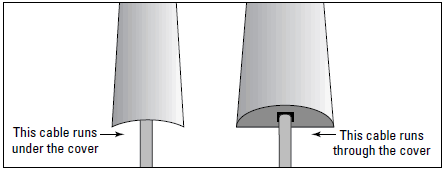Using floor cable covers
In any networking situation, a certain amount of cable is exposed because you have to run cable between the wall and the NIC in the computer. The best way to hide as much cable as possible is to put the computer desk against the wall at the point where the cable exits the wall. If that solution isn't possible, cover the cable that runs between the wall and the computer. Floor cable covers can help make your network installation less ugly and can also provide safety by eliminating the chance of tripping over the cable.
Floor cable covers come in two models: covers that lie atop the cable and covers that hold the cable in a channel (see Figure below). Both cover types provide several advantages over loose cable:

- Cable covers hug the ground and don't move. You can't accidentally nudge them up into the air as you walk and then trip over the loop you created (which is what frequently happens with Ethernet cable).
- Cable covers are wide. And the slope to the top of the cover is very gentle, which lessens the chance that you'll trip.
- You can use cable covers under a rug. Don't run cable under a rug without a cover, because the rubbing of the underside of the rug against the cable can weaken or break the cable's insulation jacket.
Most floor covers are made of plastic or rubber. You can paint the plastic covers, but I find that paint wears away quickly on rubber. If you're running the covers over a carpet, you can even glue carpet strips to the top of the cover, which may help hide the fact that your family room is crawling with cable.
In this tutorial:
- Installing Ethernet Cable
- Ready, Set, Run
- Ethernet cable has many aliases
- Concerning the concentrator
- Deciding Where to Put the Concentrator
- Concentrators are environmentally fussy
- Concentrators are innately powerless
- Distance Depends on What You Choose to Measure
- Handling Cable Correctly
- Connecting two patch cables
- Making your own patch cables
- The Chase Is On: Running the Cable
- Cabling within a room
- Cabling between adjacent rooms
- Cabling between nonadjacent rooms on the same floor
- Keeping your drill holes in the closet
- Cable that's all walled up
- Cabling between Floors
- Adding cable faceplates
- Using floor cable covers
- Curing Your Network's Growing Pains
- Don't add another router
- Getting into the Zone
